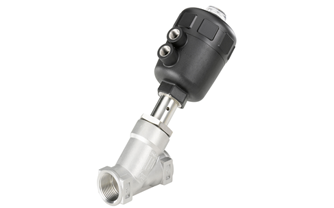

Bürkert’s externally piloted angle seat valve is operated with a single or double-acting piston actuator. In this blog, Fluid Controls explains the features and benefits of the Bürkert Type 2000 angle seat valve.
An angle seat valve is a pneumatically-controlled valve that has a piston actuator providing linear actuation to lift a seal off its seat. The seat is set at a certain angle to provide the maximum possible flow when it is unseated.
Angle seat piston valves are suited to applications where large flowrates and high temperatures are required, such as steam or water. When used in reverse, some models of angle seat piston valve will eliminate water hammer during operation.
Bürkert’s 2000 Series of externally piloted angle seat valves are operated with a single or double-acting piston actuator. The actuator is available in two different materials, depending on the ambient temperature. High flow rates are attained with the virtually straight flow path.
The reliable self-adjusting packing gland provides high sealing integrity. These maintenance-free and robust valves can be retrofitted with a comprehensive range of accessories for position indication, stroke limitation or manual override.
Here are some more key design features of the Bürkert Type 2000:
Find out more about our complete range of Bürkert valves by speaking to a Fluid Controls adviser on +44(0) 1189 70 2060 or alternatively email us at fluid@fluidcontrols.co.uk.